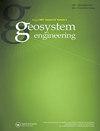Electrowinning of gold from a dilute solution using hydrocyclone-type cell
IF 1.5
Q3 GEOSCIENCES, MULTIDISCIPLINARY
引用次数: 3
Abstract
ABSTRACT The redox reaction mechanism of gold−cyanide [Au(CN)2 −] during hydrocyclone electrowinning was investigated in this work by conducting Hull cell test, potentiodynamic polarization, and computational fluid dynamics (CFD) simulations. A leaching solution of waste printed circuit boards (WPCBs) was prepared as an electrolyte, and the effects of flow rate and applied voltage on the recovery of gold and destruction of cyanide through hydrocyclone electrowinning were investigated. A numerical simulation of the flow field in the cell was performed, and the results were visualized by conducting a finite element analysis in FLUENT. The CFD simulations and Hull cell test showed that the cylindrical cathode region had a flow velocity of ~11.05 m·s−1, which was higher than that at the center of the cylindrical part (<6.45 m·s−1). The optimum conditions for electrowinning were found to be as: an electrode distance of 4.9 mm and a current density of 73.78 mA·cm−2. The anodic polarization results showed that an Ir-based mixed metal oxide (MMO) anode could more efficiently oxidize the free cyanide because of its high current density than other types of anodes (Ir-based MMO: 299.3 mA·cm−2 > SS304: 3.5 mA·cm−2 > Pt-coated Ti: 1.3 mA·cm−2). Through the demonstrated hydrocyclone electrowinning test, the gold concentration could be decreased from 100 to 0.24 mg·L−1 within 12 h while destroying almost total amount of free cyanide in a day.用水力旋流器型电解槽从稀溶液中电积金
摘要采用赫尔电池试验、电势动力学极化和计算流体动力学(CFD)模拟等方法研究了金-氰化物[Au(CN)2 -]在水力旋流器电积过程中的氧化还原反应机理。以废印刷电路板浸出液为电解液,研究了流速和施加电压对水力旋流器电积金回收率和氰化物破坏的影响。对电池内的流场进行了数值模拟,并在FLUENT中对结果进行了有限元分析。CFD模拟和Hull电池试验结果表明,圆柱形阴极区域的流速为~11.05 m·s−1,高于圆柱形部分中心(SS304: 3.5 mA·cm−2 > pt包覆Ti: 1.3 mA·cm−2)。通过水力旋流器电积试验,可在12 h内将金的浓度从100 mg·L−1降至0.24 mg·L−1,并在一天内几乎消灭全部游离氰化物。
本文章由计算机程序翻译,如有差异,请以英文原文为准。
求助全文
约1分钟内获得全文
求助全文

 求助内容:
求助内容: 应助结果提醒方式:
应助结果提醒方式:


